For SMB Brands, More Messaging Channels Means More Impact
Published on December 17, 2021/Last edited on December 17, 2021/10 min read


Brendan O'Connor
Customer Insights Analyst, BrazeSmall and mid-sized businesses (SMBs) are having a moment. Over the past two years, we’ve seen entrepreneurship increase rapidly in connection with the COVID-19 pandemic, and while brands of all sizes have faced major challenges in today’s fast-moving environment, SMBs have continue to be a key part of the US business landscape, representing nearly 44% of total economic activity. And these companies aren’t standing still—more than 80% of SMBs are taking steps to modernize their processes and the technology they have on hand.
Our mission at Braze is to help foster human connections between customers and the brands they love, whether it’s an industry titan or new startup. We help brands all over the world, across dozens of industries and at different scales of complexity. Customer engagement matters to businesses of all sizes, but the challenges that smaller and mid-size brands face can be different from other organizations. So to better assist these organizations as they work to make the most of their customer engagement efforts, Braze launched a dedicated SMB department designed to provide targeted resources—such as this webinar, featuring Wyze, exploring how SMB brands can embrace cross-channel engagement—and insights to SMB brands as they grow and scale.
In that spirit, we decided to take a data-focused look at SMB brands and how they can make the most of their customer engagement efforts. We’ve found that SMBs often work with limited time and resources, so we wanted to share some insights to help them thrive. Our biggest takeaway? That SMB brands should seriously consider leveraging more messaging channels to reach their customers effectively.
When It Comes to Messaging Channels, More Is More
Brands can no longer rely on just one channel to reach all of their customers. That new reality has made it essential for companies of all sizes to embrace a cross-channel approach to customer engagement. In fact, Braze research has found that using a cross-channel approach can boost companies’ average user lifetime by 76%.
Our analysis suggests that across many of the major outcomes that our customers focus on—such as retention, engagement, and purchases—using more channels means better results for SMBs. The upshot? By moving beyond single-channel approaches, SMBs can do more than just more effectively reach their customers; they can also inspire them to take key actions with more success.
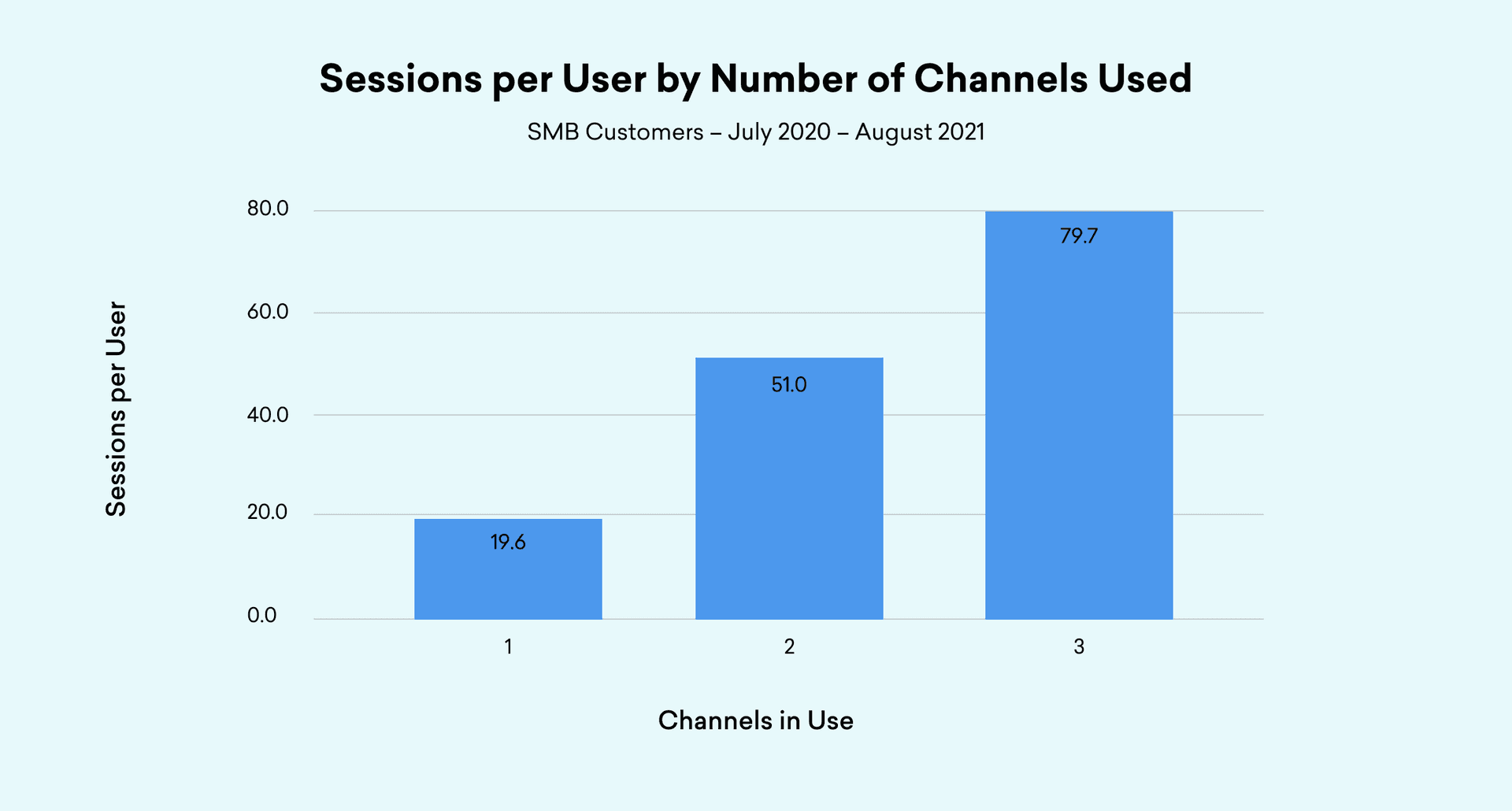
For SMB brands, session activity per user exhibits a clear upward trend as more channels are used to communicate with customers. In fact, this metric rises by more than 2.5X and then by 4X when you add a second and third channel to your messaging mix, respectively.

We also see a pronounced upward trend in terms of purchase activity when additional channels are used to message customers. SMB brands that connect with their customers across at least three channels saw 5X higher purchases per user when compared to those that used only one channel.
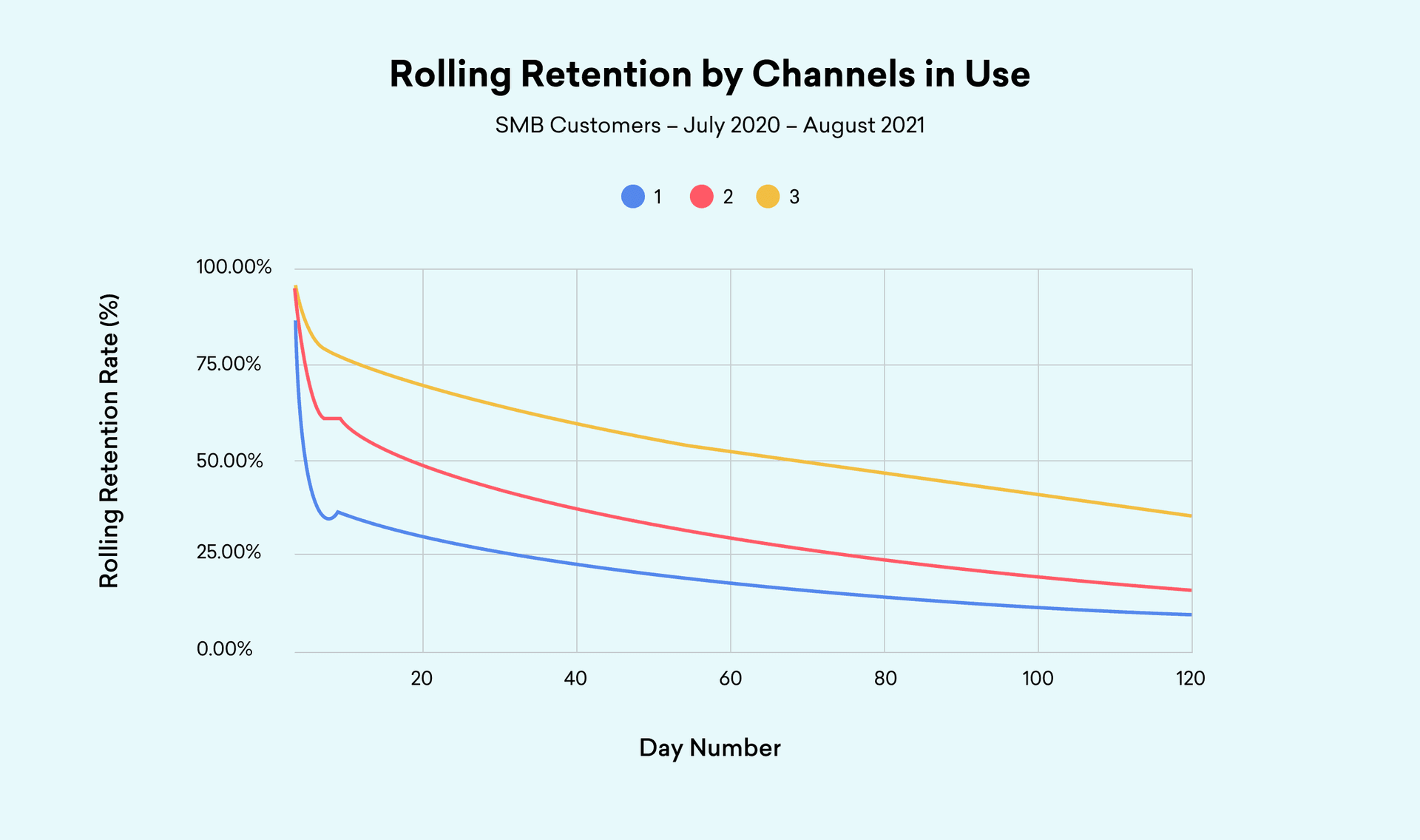
Rolling retention illustrates that adding additional messaging channels can also have an outsized impact on the odds that users return to your app or website. No matter how many days it has been since a user’s first session, adding communications channels to reach those users has a big influence on whether they stick around longer. In particular, we found that brands who used three channels to message customers saw 120-day customer retention rates that were nearly 4X higher than brands that took a single-channel approach.
What does that all add up to? Well, that using more channels results in better outcomes for SMBs. So no matter which—or how many—channels you’re currently using, it’s likely a smart move to start looking for the next one to add to your mix.
Messaging Channel Impacts: A Closer Look
At their core, messaging channels are designed to deliver content to your brand’s customers across different platforms and devices. But each channel comes with its own strengths and its unique impact on your customer engagement goals. So let’s take a look at three core channels—in-app messages, mobile push notifications, and email—and how they influence the results seen by SMB brands.
1. Across the Board, In-App Messages Drive Impressive Results
The first stop on our tour is a channel that’s a clear driver of positive outcomes for SMB brands—namely, in-app messages (IAMs). While in-app messages are sometimes defined as purely mobile messages in nature and contrasted with in-browser messages, which are used to engage web visitors, in this analysis, “in-app messages” refer to messages sent either within a brands’ app or website.For every metric we looked at, the presence of IAMs in an SMBs’ messaging mix resulted in more positive outcomes. In a world without many unalloyed positives, IAMs are that rarest of rare commodities for marketers: A sure thing.
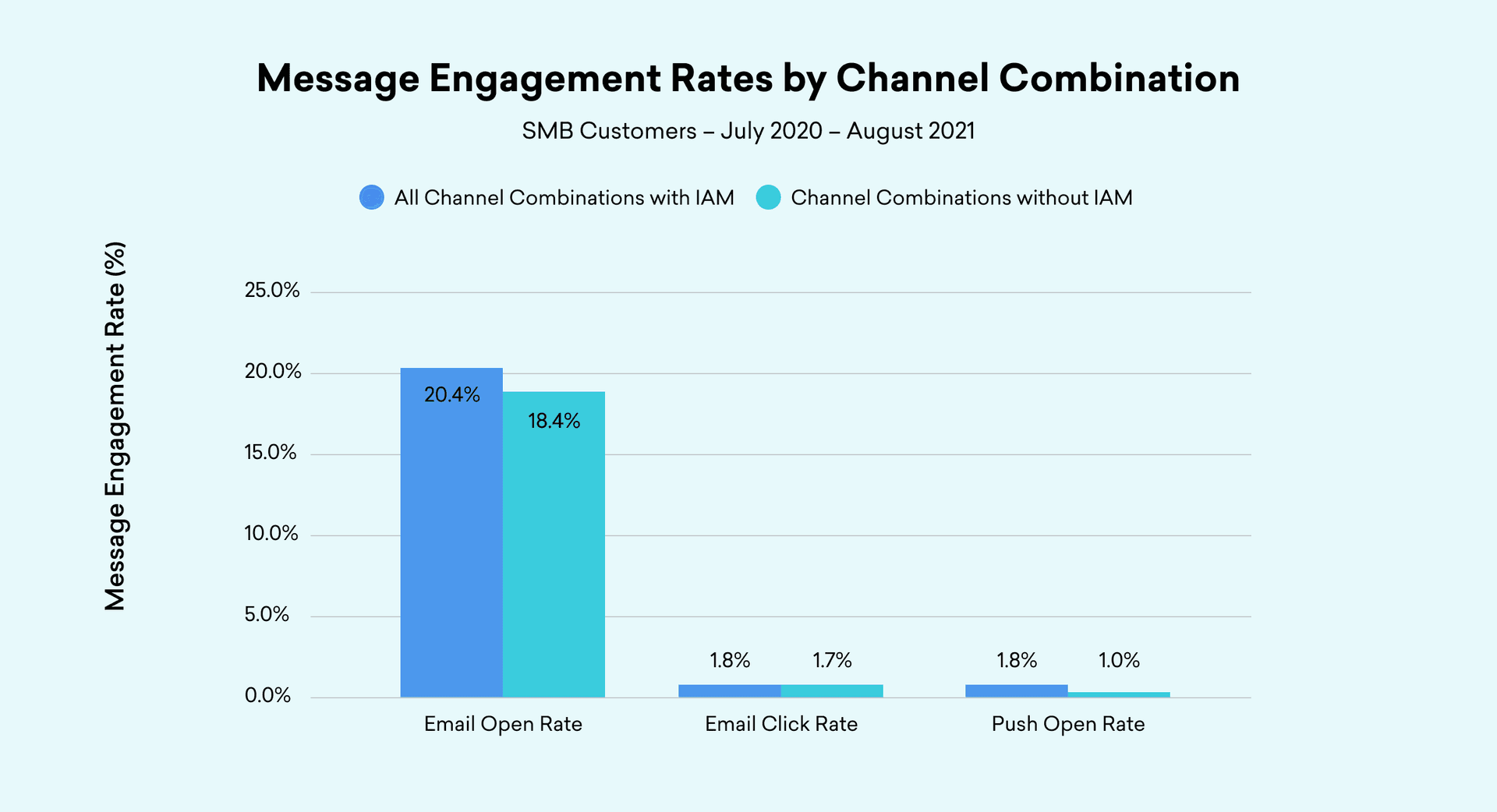
The usage of IAMs is associated with higher engagement rates across all other messaging channels. That speaks to their apparent ability to go beyond engaging users to actually make users more invested in the outreach you send in other channels.
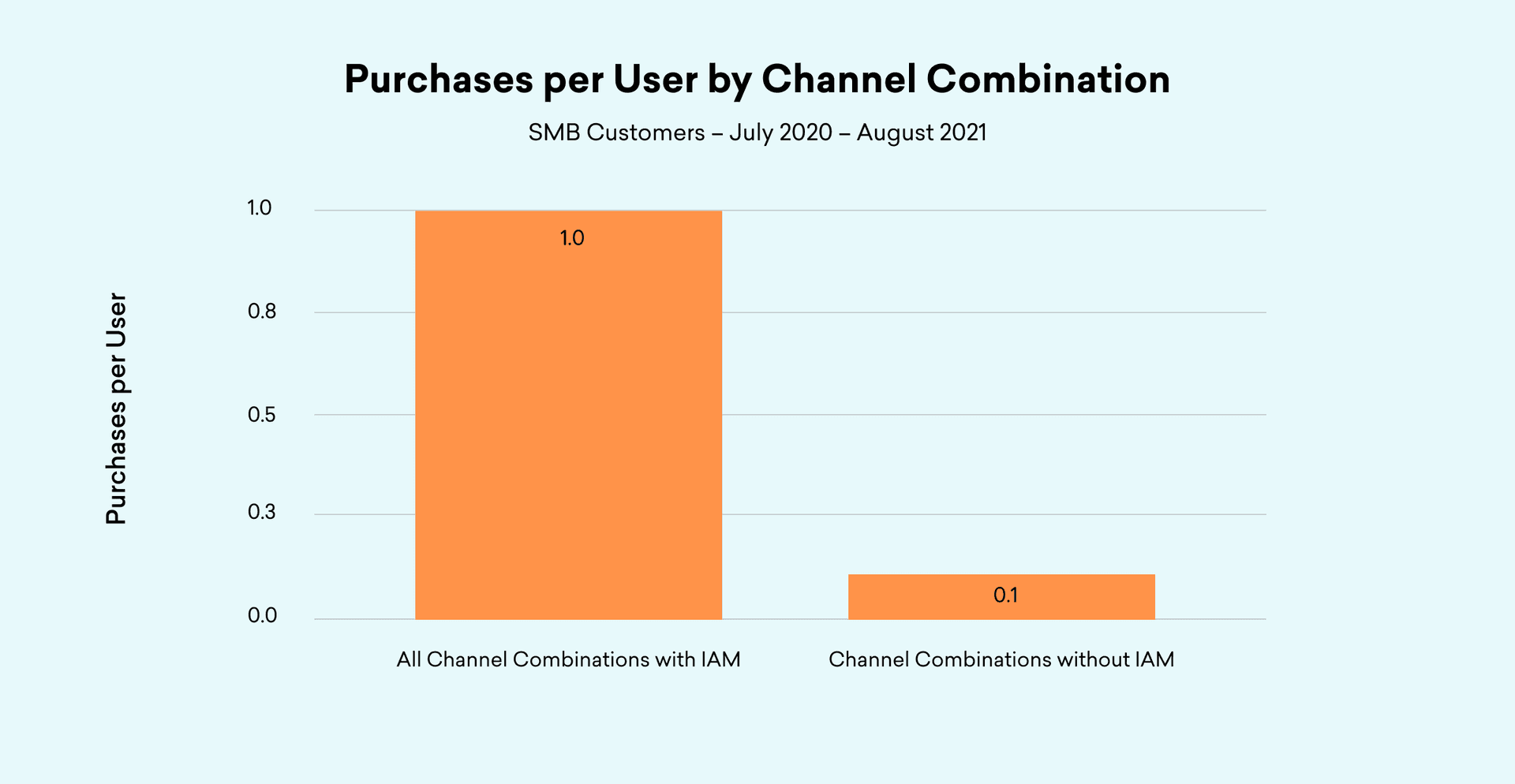
According to our research, users who receive an IAM make purchases 10X more frequently than users who do not. For brands in verticals that are laser-focused on driving more purchases (like retail and eCommerce, for instance), it’s clear that connecting with users through IAMs is one of the most impactful things you can do to bolster purchases and revenue.
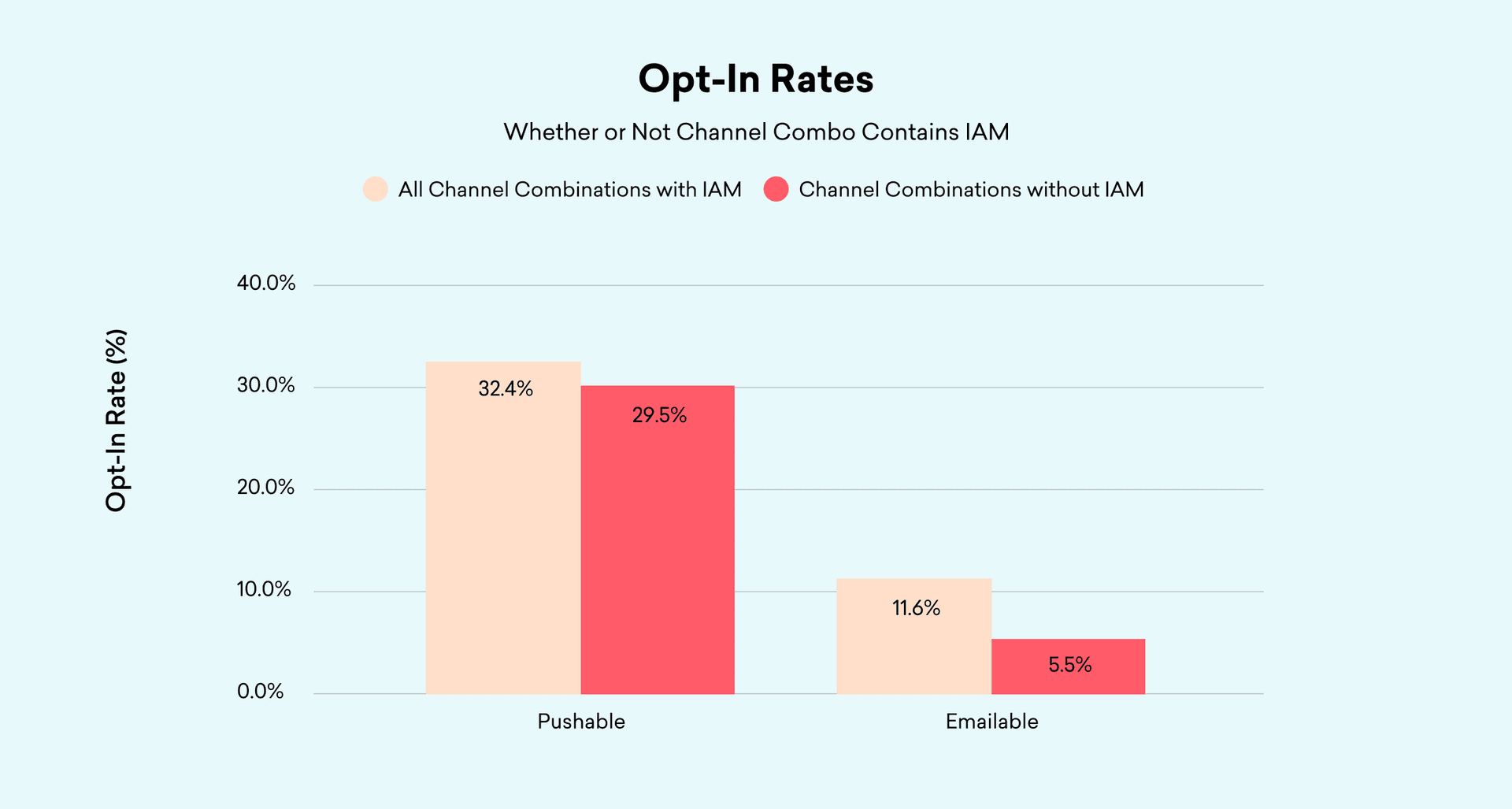
In-app messages are also very effective at driving users to opt-in to other channels, making it a highly efficient way to improve your cross-channel engagement. For one thing, users who receive IAMs are twice as likely to be opted in to receive email messages on average. And while the impact is a bit less pronounced for push notifications, users who receive IAMs are still about 10% more likely to be opted-in to push. If you’re interested in learning more about how to increase your opt-in rates for other channels using IAMs, be sure to check out our Braze Inspiration Guide, which explores message channel and data opt-ins in more detail.
Regardless of the other channels you’re using, in-app messages can act as a force multiplier for your engagement efforts. Given these positive impacts, SMBs should think seriously about incorporating IAMs into their customer engagement strategy if they aren’t already.
2. Email and Push: Better Together
While every SMB brand has its own unique goals and—often—its own messaging channel mix, our analysis found some trends when it came to what channels small and mid-sized brands used to support their customer engagement efforts.
For one thing, SMB brands are more likely than larger companies to make use of email rather than push notifications, especially when a given brand is using two or fewer messaging channels. Is this a missed opportunity for SMBs to benefit from push? Or is using two out-of-product messaging channels potentially overwhelming for some customers? To help SMB brands make the most of their messaging, we decided to investigate.
The big finding? When it comes to engagement, purchase behavior, and retention, we see significantly more positive results when SMB brands communicate with customers via both push and email, making a strong case for using both channels in tandem.
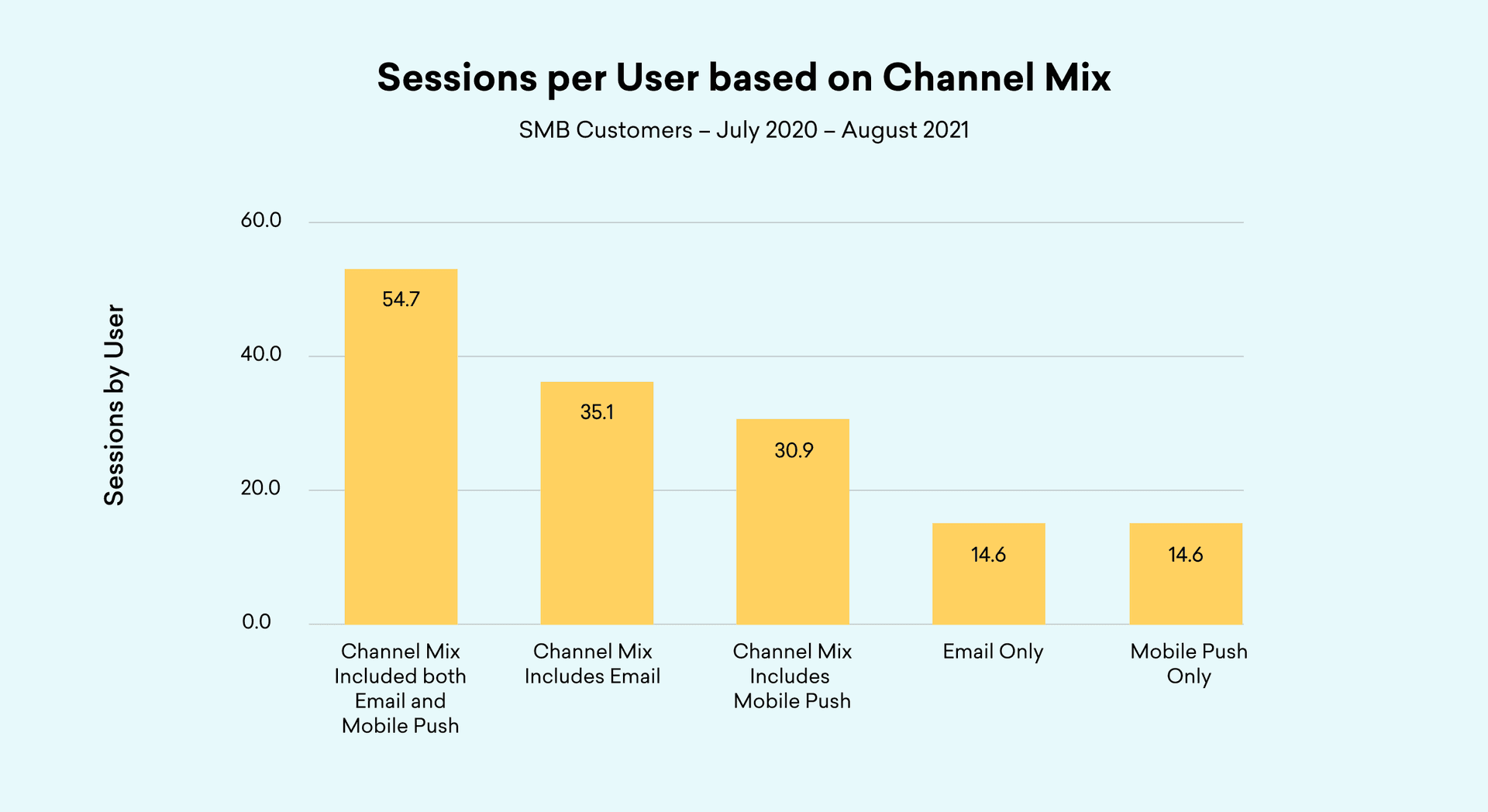
For one thing, using both email and push together is 3.7X more effective than sending exclusively email or mobile push when it comes to driving user sessions. The channel combinations that include both are also more impactful than those containing one or the other in conjunction with other messaging channels, suggesting that this dynamic is an enduring one.
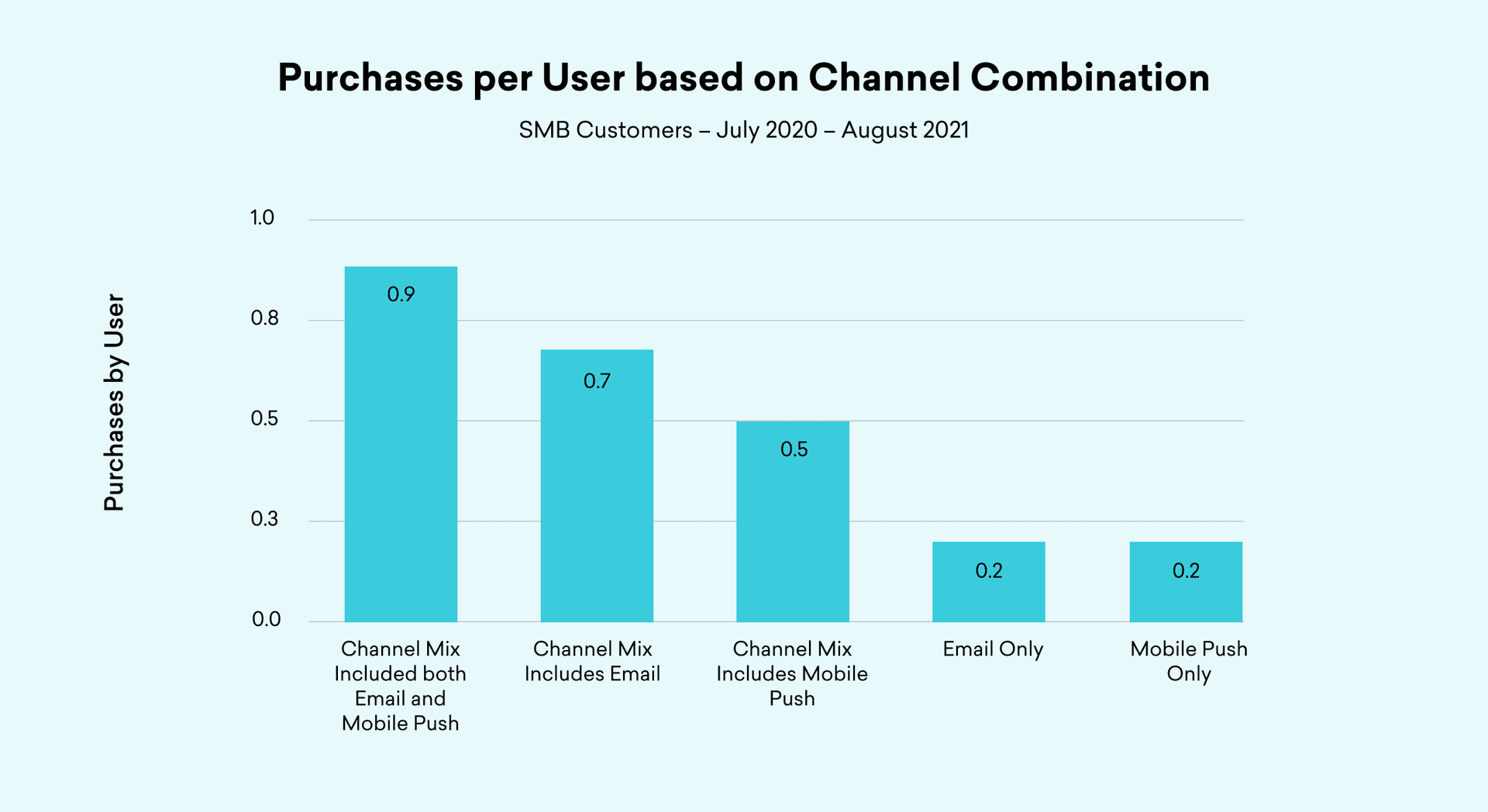
Looking to drive more purchases? Our research found that purchases per user are 4.5X higher when recipients were sent both email and push notifications, compared to communicating via either channel in isolation.
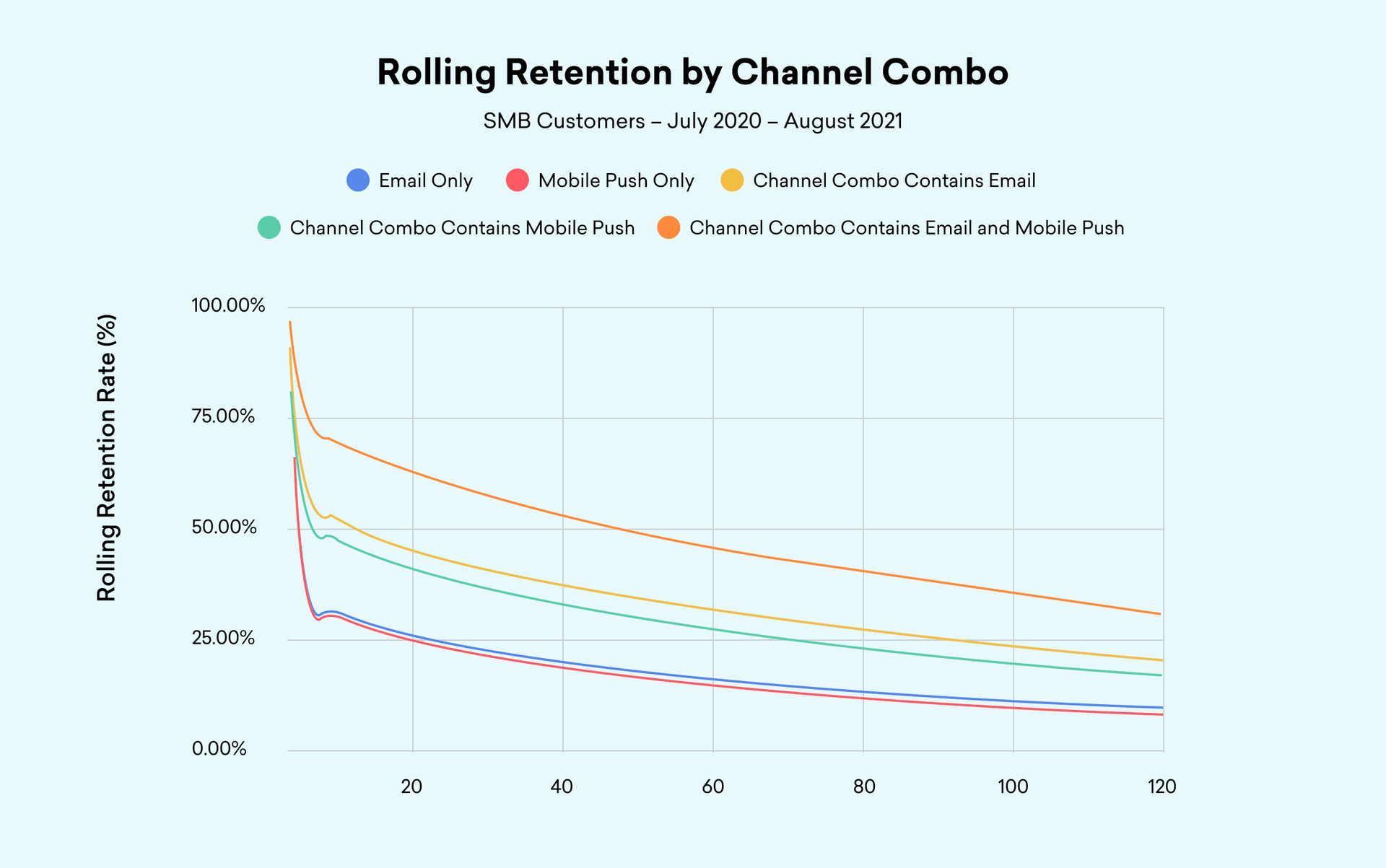
We see a similar dynamic when it comes to user retention. Consumers who received both emails and push notifications are more likely to be retained on every single individual day through day 120 of their time with a given SMB brand.
The upshot? If you’re an SMB brand and only have the capacity to support a single messaging channel, that channel should likely be email. However, if it’s possible for you to supplement your email marketing efforts with push notifications, you should consider embracing that approach, as it will lead to stronger downstream results for your business.
3. When It Comes to Driving Purchases, Don’t Sleep on Web Push
Web push notifications are something of an unsung hero in the SMB space. Our research found that SMB brands use web push at a 26% lower rate than other businesses, but that underutilization is a big missed opportunity and something that brands should consider changing. Why? Well, for one thing, our research found that web push is an incredible performer when it comes to driving positive purchase outcomes for your business.
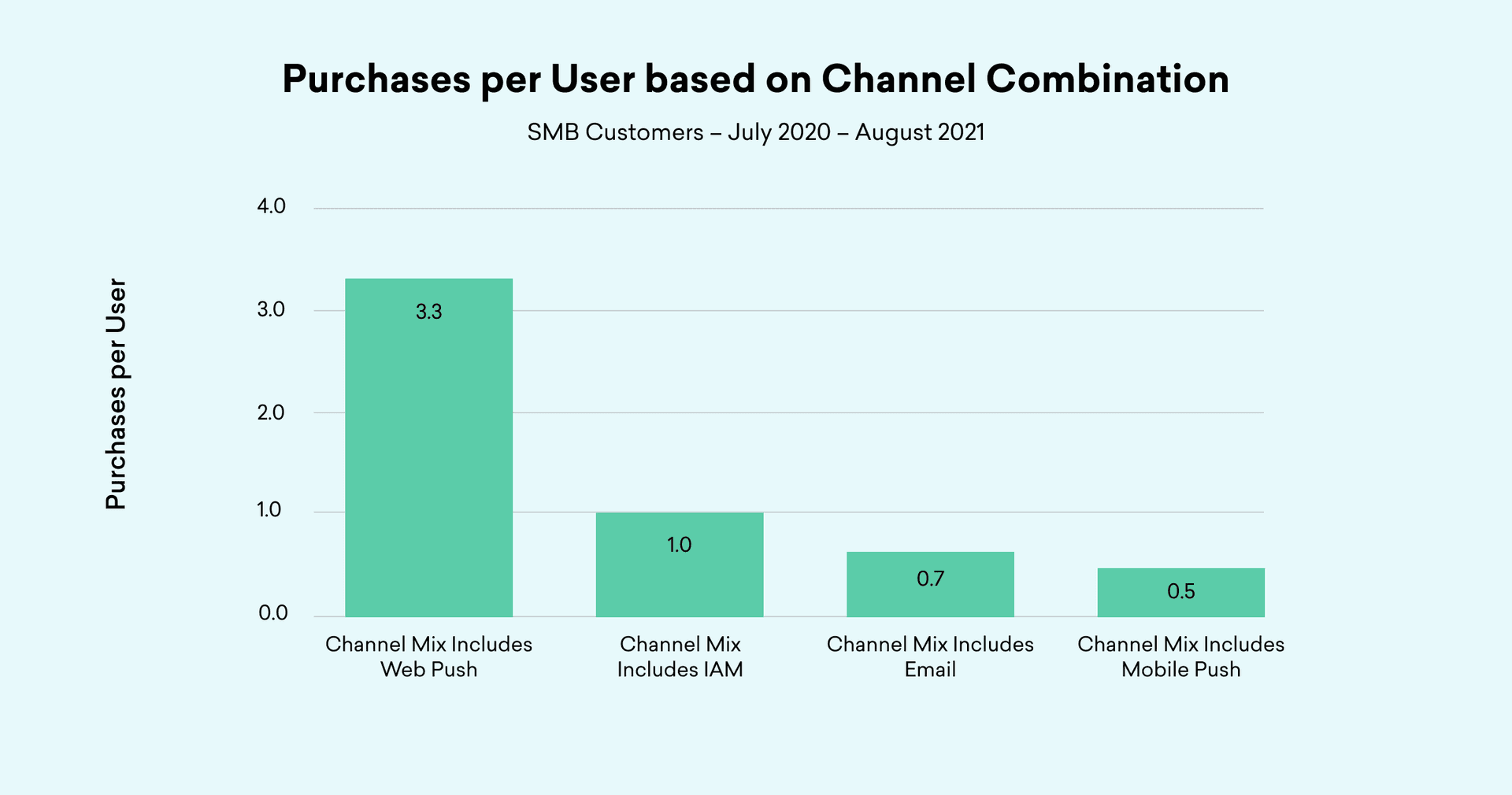
One eye-catching result? SMB customers who receive web push notifications as part of their engagement mix see 3.3X the number of purchases compared to the next highest-performing channel (in-app messages, as it happens).
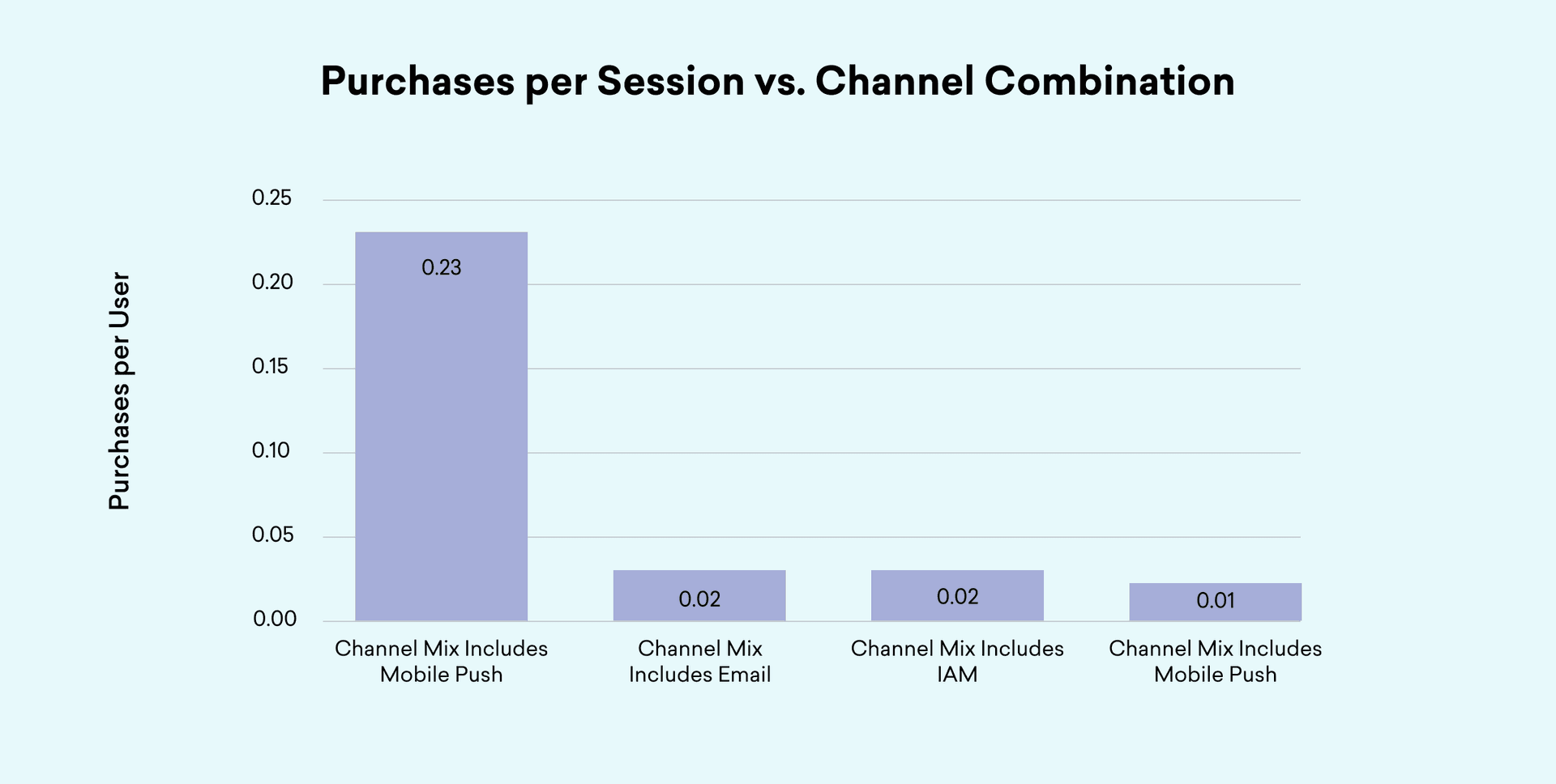
If you dig into purchases on a per session basis, the dynamic becomes even more pronounced. According to our research, users who receive web push notifications as part of their engagement mix make 10X more purchases per session than the next highest-performing channel (email in this case).
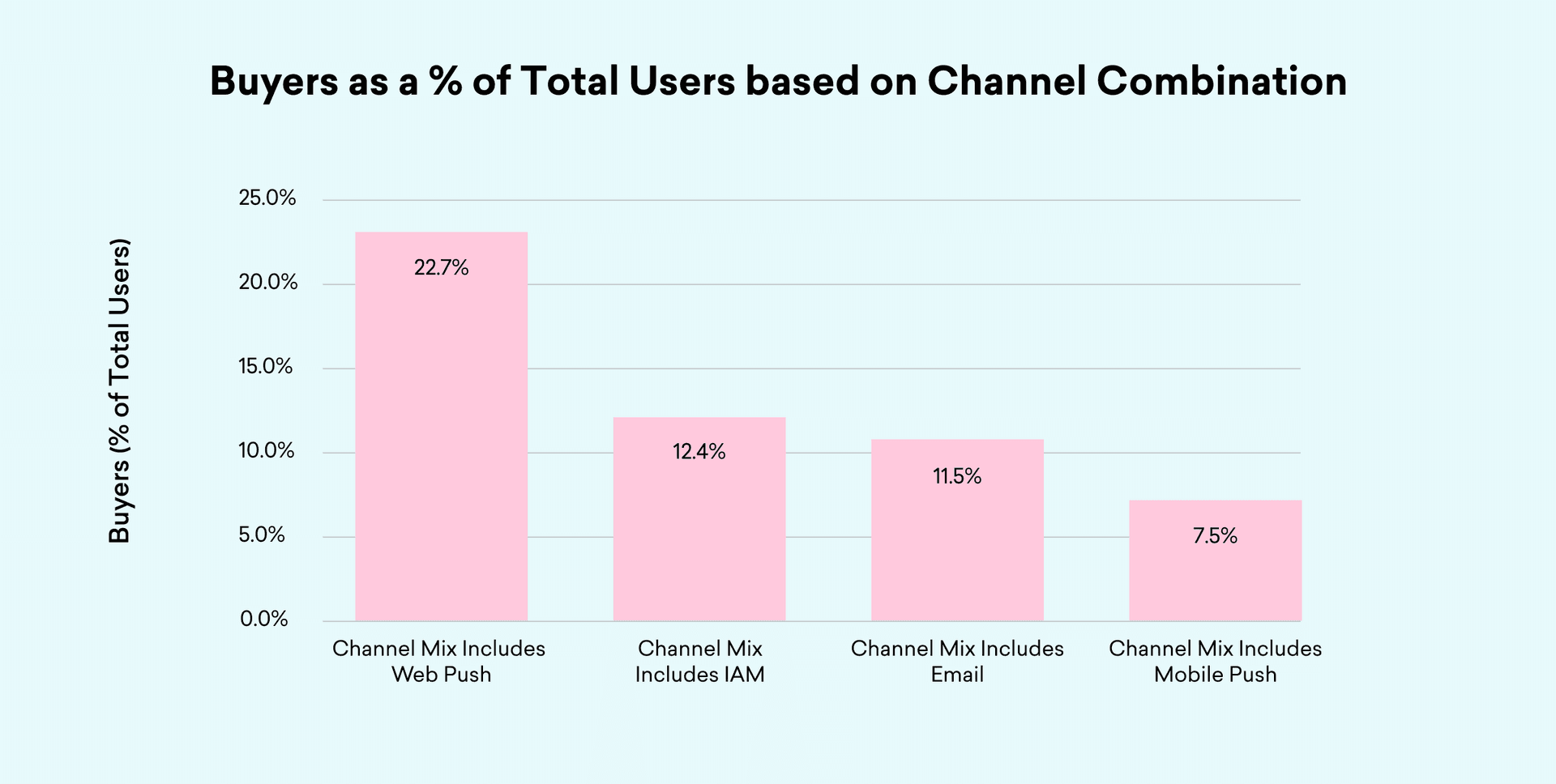
Another key insight? Users who receive web push from SMB brands are 83% more likely to be a buyer—that is, a user who actually makes a purchase—than those who received messages in the next highest-performing channel (IAMs in this case).

These results are big and significant. That said, while web push is a powerful customer engagement tool, it’s important to remember that it’s not a silver bullet; for one thing, customers tend to opt in for web push notifications at a much lower rate than for mobile push or emails, reducing the number of customers who can be reached this way for many brands.
However, if your SMB brand has a notable web presence and you’re looking for ways to encourage customers to return to complete a purchase, let visitors know that a favorited item is back in stock, or other key out-of-product messaging use cases, web push should be on your short list of channels to leverage. Try encouraging users to opt-in for web push by using an in-browser message that highlights the valuable updates they’ll enjoy by enabling push notifications from your brand!
What Channel Combinations Have the Biggest Impact on Each Key Metric?
Successful cross-channel messaging is all about finding the right mix of channels for your audience and your business goals and deploying them in concert to provide brilliant experiences that get results. While your specific brand’s results may differ, our research found that these specific channel combinations result in the biggest impact on average for each of the four following metrics:
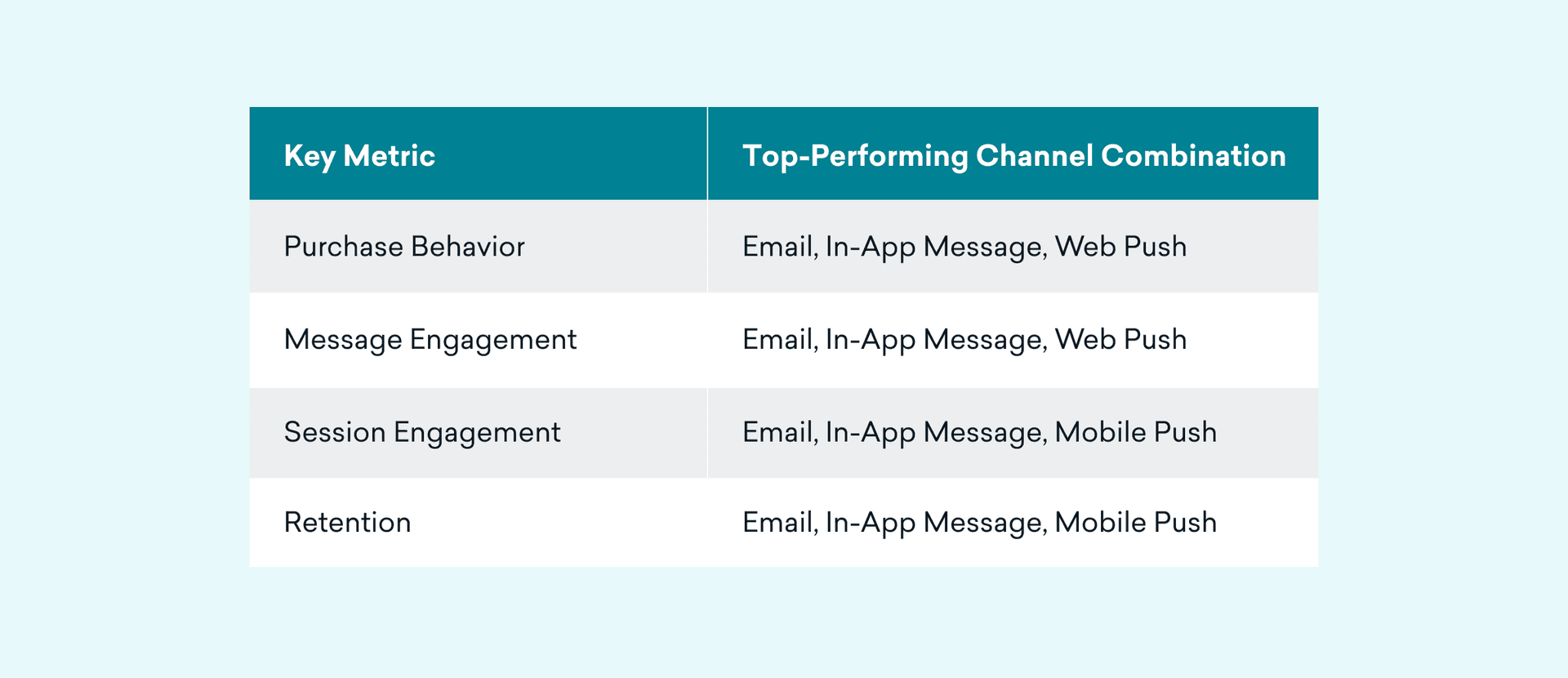
One thing to note? All of the most effective combinations have three messaging channels and include in-app messages and email. The biggest difference is whether mobile or web push helps to move the needle the most.
Final Thoughts
Here at Braze, we talk a lot about cross-channel customer engagement, and there’s a reason for that. Our research has shown that embracing cross-channel can supercharge SMBs’ customer engagement efforts and help them reach users more effectively. But the journey isn’t over when you decide what new channels you need to add; you also need a plan for how to expand your channel mix in smart, scalable ways.
To get up to speed on today’s key channels and how to get started using them, check out “Brilliant Experiences, Channel by Channel.”
Methodology
For this analysis, we looked at messaging-related data for current Braze SMB customers—defined as brands with 200 or fewer employees that have sent at least messages to at least 1,000 unique recipients per month—between July 2020 and August 2021.
Related Tags
Be Absolutely Engaging.™
Sign up for regular updates from Braze.
Related Content
View the Blog
The new inbox reality: How iOS changes are reshaping email marketing

Aparna Prasad

Experience optimization: Turning data insights into better journeys

Team Braze

December 2025 Bonfire Marketer of the Month: Jagex’s Emma Oliver
